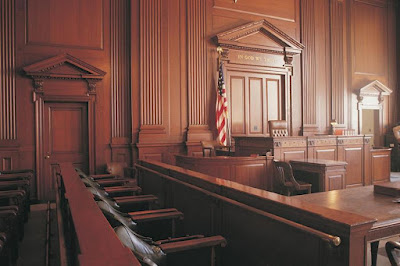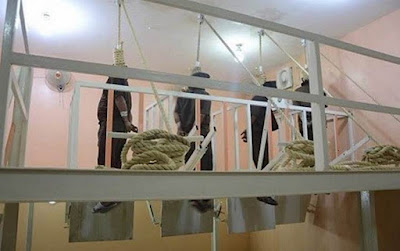On April 19, 1949, Judge Kennon Whittle addressed prosecutors and defense lawyers gathered in his 2nd-floor chambers of the Henry County courthouse.
They would soon be handling the volatile case of seven black men charged with raping a white woman, and Whittle admonished them that the accused "will be tried as though both parties were members of the same race. I will not have it otherwise."
At the time, all 45 men executed for rape in Virginia since the state began using the electric chair in 1908 were blacks convicted of attacking white women. 2 weeks after Whittle's warning, the Martinsville defendants were convicted and sentenced to join them.
The sentences were carried out in February 1951, the largest group of executions for crimes against a single victim in state history and 1 of the largest in U.S. history. Virginia would later execute 3 more men for rape, the last in 1961.
Rape is no longer a death-eligible crime in the U.S., but 60 years later, the executions of the Martinsville 7 still provoke strong feelings in Martinsville's African-American community and among death-penalty critics.
Washington and Lee University law professor David Bruck said that even if the trials were fair and the men guilty, "the idea that you could have a 45-to-0 ratio and that does not prove anything ... tells you that this was simply a judicial system that was not prepared to do the right thing."
What the Martinsville case lacked in legal import, it made up for politically by drawing national and worldwide attention to the death penalty as a civil-rights issue.
Much of that attention was focused on Richmond, home of the governor, the legislature and the state's top civil-rights lawyers, as well as the location of what was then the Virginia State Penitentiary and its electric chair.
In Martinsville, the executions are no longer a common topic of conversation, but they remain on the minds of many African-Americans.
"It's such a raw wound," said Naomi Hodge-Muse, president of the Martinsville chapter of the National Association for the Advancement of Colored People. "The older people all know about it, and it's so hurtful that they don't really want to talk about it.
"No one believed they should get off free … " she said. "But to kill them and not even really know that all of them even committed this crime?"
She also asked, "How many black women have been raped in Virginia and nobody has ever been executed?" (Figures for 1949 are not available, but 1/3 of the 1,505 rape victims in the state in 2009 were black women.)
As far as Hodge-Muse and many others are concerned, the case "was just such an evil miscarriage of justice."
The original trial records, including hundreds of pages of transcripts, are on file at the Martinsville Circuit Court clerk's office.
Each man was charged with rape and aiding and abetting rape — both crimes punishable by death at the time. All but 1 were young and single, and all were employed — 3 in a sawmill, 1 a plasterer's helper, 1 a stonecutter and 1 a foundry man.
There were 6 trials — 2 defendants elected to be tried together — held back to back, none of them lasting more than a day. Prospective jurors in each trial included some blacks, but all 72 jurors selected to try the cases were white.
Eric W. Rise, author of "The Martinsville 7, Race, Rape and Capital Punishment" and a professor of criminal justice at the University of Delaware, said prospective black jurors were excused for expressing reservations about the death penalty or struck by prosecutors.
After the verdicts and sentencings, the Virginia Supreme Court of Appeals later rejected a racial-prejudice claim filed on behalf of the Martinsville 7, ruling that sentences did not, "depend upon the race of the accused, but upon the circumstances, aggravation and enormity of the crime proven in each case." And in the justices' unanimous opinion, as far as the Martinsville 7 case was concerned, "one can hardly conceive of a more atrocious, a more beastly crime."
The trial transcripts show that on the evening of Saturday, Jan. 8, 1949, Ruby Stroud Floyd, the 32-year-old wife of a department-store manager, entered a black area of the city to collect money owed her by Ruth Pettie, a woman to whom she had sold clothing.
Floyd did not know where the woman lived, so she enlisted the help of 11-year-old Charlie Martin, son of a "colored" woman she knew, to guide her. Martin and his uncle later testified that the uncle warned Floyd not to make the trip in the dark.
Though they varied somewhat in detail, the accounts of what happened that night from the perpetrators, the victim, Martin and other witnesses in large part agreed.
Joe Henry Hampton, 21, was the first man tried. His signed confession, like those of the others, was read into the record and can be found in the old files.
Hampton said he, Howard Hairston, Booker T. Millner and Frank Hairston Jr., were drinking wine near some railroad tracks that Saturday night. "A white lady and a little colored boy came by and the lady asked where Ruth Pettie lived ... we all planned to get her when she came back."
When she and the boy returned, Hampton said he grabbed her and the others joined in the assault, according to his confession.
"Booker T. gave the little colored boy a quarter and told him to go (away)," Hampton told police. Later, 3 other men, Francis DeSales Grayson, John Clabon Taylor and James Luther Hairston joined the other 4 in the assault, according to the confessions.
A physician who treated Floyd after the attack testified that she suffered a swollen lip, scratches on the back of her neck, the back of her right chest and on her buttocks. She also had abrasions on her elbows, forearms, knees, lower legs and thighs. She was emotionally upset, said the doctor, her underclothing was missing and her coat, dress and slip were "extremely dirty."
Although it was dark, Floyd testified in all 6 trials identifying each of the 7.
4 of the 7 testified at their own trials. Some questioned the accuracy of parts of the confessions, and at least one said he did not have intercourse with Floyd and that he did not see Floyd resist anyone.
Among the key witnesses against the men was 11-year-old Charlie Martin. A prosecutor asked him: "Charlie, do you know what happens to little boys who tell lies when they die?"
"Yes, sir," responded the youth.
"What?" he was asked.
"Go to hell," he responded.
Other prosecution witnesses included Grayson's wife, Josephine, who also testified for the defense in some of the cases; a sister of 1 of the defendants; and a black woman who assisted Floyd after the attack.
Unanimous juries recommended death sentences at the end of each trial. The longest deliberations lasted less than 2 hours, Rise said.
After the convictions, the 7 were represented by Richmond-area civil-rights lawyers Martin A. Martin, Samuel W. Tucker, Roland D. Ealey and Oliver W. Hill, and others.
In their 1st appeal to the Virginia Supreme Court of Appeals in 1950, the lawyers argued among other things that the death sentence for rape in Virginia was reserved for blacks.
Records unavailable at the time of the Martinsville 7 appeals show that from 1626 until 1908, at least 3 whites and 99 blacks were hanged for rape or attempted rape in Virginia. After Virginia became a state and until the end of the Civil War, state law allowed only blacks to receive a death sentence for rape. In 1866, the state legislature changed the law so that execution remained an option for both races in rape cases.
In 1908, Virginia became the 5th state in the U.S. to use the electric chair, and executions were carried out by the Virginia Department of Corrections at the State Penitentiary in Richmond. For the 1st time, records were kept at a central location.
The 1st man to die in Virginia's electric chair was Henry Smith, a black man who raped an elderly white woman.
The Library of Virginia has the letter from the lawyer, Martin, asking for execution data. W.F. Smyth Jr., the penitentiary superintendent, wrote a succinct response: "No white person has ever been electrocuted in Virginia for the crime of rape; or attempted rape."
The lawyers used the figures in their clemency petition to Gov. John S. Battle. But on July 24, 1950, Battle turned them down, writing: "No fair minded person can read the evidence in these cases without being convinced, beyond the shadow of a doubt, of the guilt of all the defendants."
"It is worthy of note that none of the defendants claimed that promises or threats were made by anyone before the confessions were signed," he wrote.
Rise said that after Battle's clemency rejection, Martin filed a writ of habeas corpus — a civil challenge to the death sentences — arguing that the seven were denied equal protection under the law guaranteed by the 14th Amendment.
That appeal failed, too, however. The judge ruled that there was no evidence that discrimination was involved in imposing the Martinsville death sentences. Appeals to the Virginia and U.S. supreme courts followed but also failed.
Bruck said the Martinsville 7 case was the 1st in which statistics were used in a racial challenge to death sentences. And, he asserts, it is "the most dramatic example of how the American judicial system has simply refused to face the facts about race and capital punishment."
It was not until a 1977 Georgia case that the U.S. Supreme Court ended death sentences for rape, but because the death penalty was a "grossly disproportionate" punishment for rape, and not on the basis of race.
As the final execution dates of Feb. 2 and Feb. 5, 1951, approached the governor's office was flooded with thousands of telegrams, including 1 from Moscow, asking that the men not be executed.
Still, preparations for the executions proceeded. The night of Feb. 1, 1951, hundreds of people of both races gathered at the state Capitol to pray.
The next morning, a Friday, 75 people were praying at the Capitol when several blocks away at the penitentiary on Spring Street, Department of Corrections records show that Hampton, 21, was seated in the electric chair at 8:04 a.m. He was pronounced dead at 8:12 a.m. 3 more executions quickly followed.
2 days later, on Sunday, 100 people picketed the White House in Washington, and Josephine Grayson, wife of Francis Grayson, unsuccessfully sought to see President Harry S. Truman.
In Richmond, more than 200 people, most wearing black armbands, marched to Capitol Square from a memorial meeting at Third Street Bethel AME Church.
But the remaining 3 men were executed on Monday, Feb. 5. The last was Grayson, 38, who was pronounced dead at 8:15 that morning.
In his study on the case, Rise concluded that, "At a time when African-Americans were beginning to assert their civil rights vigorously, the executions provided a stark reminder of the harsh treatment reserved for blacks who violated Southern racial codes."
Martinsville remained quiet. There had been no threats of lynching before the trials and no disturbances after the executions.
Tony L. Millner, vice president of the Martinsville NAACP chapter, said he was a child when it happened. "I was maybe 10 years old, and it was very, very, very hush-hush," he said.
"Most of the time, the families, the people who were of age in that era, they talked about it in private homes, in churches and other places ... and always felt as though it was really a serious injustice."
Hodge-Muse says, "This community does not have a hateful attitude that would lend itself to violence ... that's not our culture, and I think it speaks well of the black and white community that we have never had that type of meanness."
But Hodge-Muse, Millner and others also believe that not all the facts came out during the trials and that there are many unanswered questions.
Hodge-Muse said it was common knowledge that the victim spent a great deal of time in the black community. "This was the Jim Crow South; this was prior to the civil-rights movement ... why would she be there," she asked.
"I am not excusing rape. It is a filthy, sick crime," Hodge-Muse said. "But we don't really know what happened."
Another person who wants to learn more is Denise Grayson, 46, of Raleigh, N.C., a granddaughter of Francis Grayson.
Reached by telephone, she said her family will not talk about her grandfather or what happened. "They won't discuss that at all," she said.
Grayson said she once told her father that she wanted to meet her grandfather. "I think I touched a nerve. He said, 'Well, read the book the Martinsville 7.'"
She said her grandmother, Josephine Grayson, now living in Maryland, "will not speak on that at all under (any) circumstances."
It is not known whether Floyd is still alive and if so, where.
Doris Gravely, 80, of Martinsville, a 1st cousin of Joe Henry Hampton, the 1st of the 7 executed, talked about the case in her living room last month.
"My daddy was Hampton's uncle," she said. She said her father, her uncle and Hampton's brother visited Hampton at the jail while he was awaiting trial and that Hampton told them they were making him sleep on the cement floor without clothes.
Gravely also does not believe everything has come out about the case. But, she said, "It's been so long, ain't no need of digging in it now."
Another who believes the past is best left alone is Charlie Martin, the young boy who accompanied the victim and repeatedly testified at the trials. He is now in his 70s and lives just outside the city of Martinsville.
"I won't talk about that," Martin said. "I don't want to bring that up again."
Source: Richmond Times-Dispatch, February 5, 2011
_________________________
Use the tags below or the search engine at the top of this page to find updates, older or related articles on this Website.


.jpg)







